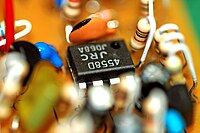User:Herbxue/sandbox/klon centaur

The Klon Centaur is a guitar overdrive pedal, made by Bill Finnegan. The pedal is characterized as a "transparent" overdrive, meaning it adds volume gain, overdrive, and distortion to the signal without significantly altering the quality of the guitar's tone. This quality is often contrasted with "tube screamer"-style pedals that add significant mid-range to the guitar's tone. The Centaur is one of the most sought after and most copied overdrive pedals.
Description
The pedal has a drive knob, a tone knob, and a level knob. The drive knob adjusts gain, the tone knob adjusts treble and the level knob adjusts the output volume of the pedal. The pedal is used to try to mimic the sound of a vintage tube amplifier. The classic Tube Screamer sound includes a "mid-hump," which means that the circuit accentuates frequencies between the bass and treble ranges (mid-frequencies). Many guitarists[who?] prefer this sort of equalization, as it helps to keep their sound from getting lost in the overall mix of the band.[citation needed]
Design

Mr. S. Tamura, the designer of the Tube Screamer, used a subtle clipping circuit to create the pedal's sound. He mixed the input signal with the output signal of the clipping circuit, to "preserve the original dynamics of the input signal which otherwise would get lost at the threshold of clipping." In this fashion, it preserves the "original dynamics of the input signal [and] avoids muddiness and vastly improves clarity and responsiveness." As well, Tamura added a post-clipping equalization circuit with a first-order high-pass shelving filter that "is linearly dependent on its gain," an approach called "progressivity."[1] Characteristic of its clipping is the symmetrical nature.[2]
The Tube Screamer uses electronic field-effect transistor (FET) bypass switching. The circuit uses transistor buffers at both the input and the output. The overdrive is produced using a variable gain operational amplifier ("op-amp") circuit with matched diodes in the feedback circuit to produce soft, symmetrical clipping of the input waveform. The overdrive stage is followed by a simple low-pass filter and active tone control circuit and volume control. The TS7 allows switching between a "TS9" mode, in which the circuit and all relevant component values are identical to the vintage model, and a "Hot" mode, which introduces an additional gain stage.

Much has been made of the operational amplifier chips used in the various versions of the Tube Screamer pedal, and several articles have been written on the subject.[3][4] The JRC4558D chip is particularly well regarded.[5] In fact, the JRC4558D is used in Analog Man's "Silver" modification. Other popular chips included the TL072, RC4558P, and OPA2134.[citation needed] The TA75558, standard in the TS10 alongside the 4558, is regarded as the "ugly duckling of TS opamps."[5]
Notable users
The pedal was popularized by ###. It is widely used in genres as diverse as country, blues and shred. The Centaur has inspired many clones (called "clones") and modified versions.[6] It is also used by the majority of metal guitarists before the lead channel of the high gain amps to make distortion more focused and to cut the low end. Notable modifiers of the pedal include Robert Keeley of Keeley Electronics.[7]
References
- ^ Topaktas, Bogac. "Tube Screamer's Secret". BTE Audio. Retrieved 13 September 2010.
- ^ Zölzer, Udo; Xavier Amatriain (2002). DAFX: digital audio effects. John Wiley and Sons. p. 125. ISBN 978-0-471-49078-4.
- ^ "Ibanez Tube Screamers History". Analogman.com. Retrieved 13 September 2010.
- ^ Möller, Andreas. "The "true" TS-808 chip ..." Stinkfoot Electronics. Retrieved 13 September 2010.
- ^ a b Cite error: The named reference
hunterwas invoked but never defined (see the help page). - ^ "Ibanez Tube Screamer". musicradar.com. Retrieved 1 September 2011.
- ^ Tucker, Lindsay (November 2011). "Builder Profile: Keeley Electronics' Robert Keeley". Premier Guitar. Retrieved 20 January 2012.
External links